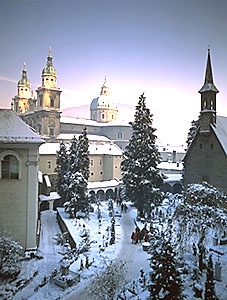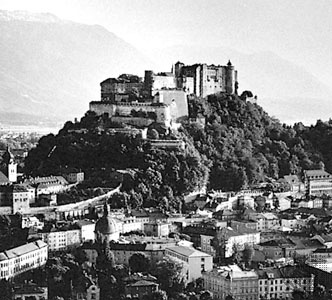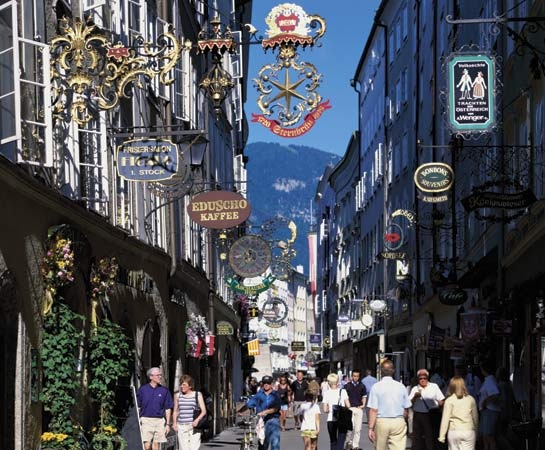Salzburg
Austria

city, capital of Salzburg Bundesland (federal state), north-central Austria. It is situated in a level basin on both sides of the Salzach River near the northern foothills of the Alps and the Bavarian (German) border. The historic centre of the city, with its rich mix of art and architecture, was added to the UNESCO World Heritage List (World Heritage site) in 1996.
Salzburg was originally the site of a Celtic settlement and later of the Roman town of Juvavum. About AD 700, the Benedictine Abbey of St. Peter and the Nonnberg Nunnery were founded there by St. Rupert. Salzburg was made a bishopric by St. Boniface (Saint Boniface) in 739 and was raised to an archbishopric in 798. Its archbishops were acknowledged as princes of the Holy Roman Empire in 1278, and the city became the seat of their powerful ecclesiastical principality. Among the most notable of the prince-archbishops were Wolf Dietrich von Raitenau (reigned 1587–1612), who brought Italian Renaissance architecture and styles to the city, notably by offering commissions to the Italian architect Vincenzo Scamozzi (Scamozzi, Vincenzo) for public squares, a cathedral, and other buildings; Markus Sittikus von Hohenems (reigned 1612–19), who continued to rebuild the city with another Italian architect, Santino Solari; Paris, Graf (count) von Lodron (reigned 1619–53), who founded the city's university (1622); and Leopold Anton von Firmian (reigned 1727–44).
A unique combination of scenic Alpine landscape and architectural richness has led to Salzburg's reputation as one of the world's most beautiful cities. Because of the building activities of its later archbishops, however, little remains of its medieval architecture, and several buildings were damaged or destroyed by fire in 1818. Its chief glories are the episcopal buildings and the burghers' houses, displaying an Italian Renaissance (Europe, history of) and Baroque (Baroque period) influence that earned Salzburg the designation of the “German Rome.”
 In the centre of the “older town,” on the left bank of the Salzach, is the Residenzplatz with the archbishop's residence (1595–1619), a gallery of 16th–19th century European paintings, and a large Baroque fountain (1658–61). Opposite is the Residenz Neugebäude (Residence New Building; 1592–1602); its tower contains clockwork (1873) and carillon (German: Glockenspiel; 1705) that was imported from Antwerp, Belg. The 35 bells that make up the carillon range in size from 35 pounds (16 kg) to 838 pounds (380 kg) and play many pieces specially composed by Michael Haydn (Haydn, Michael) and by Wolfgang Amadeus Mozart (Mozart, Wolfgang Amadeus), Salzburg's most famous native son. The cathedral, or Dom, was the first church built in the Italian style on German soil, according to plans elaborated in 1614–28. It was constructed on the site of a previous Romanesque (Romanesque art) cathedral (1181–1200; damaged by fire 1598) and an earlier, 8th-century basilica.
In the centre of the “older town,” on the left bank of the Salzach, is the Residenzplatz with the archbishop's residence (1595–1619), a gallery of 16th–19th century European paintings, and a large Baroque fountain (1658–61). Opposite is the Residenz Neugebäude (Residence New Building; 1592–1602); its tower contains clockwork (1873) and carillon (German: Glockenspiel; 1705) that was imported from Antwerp, Belg. The 35 bells that make up the carillon range in size from 35 pounds (16 kg) to 838 pounds (380 kg) and play many pieces specially composed by Michael Haydn (Haydn, Michael) and by Wolfgang Amadeus Mozart (Mozart, Wolfgang Amadeus), Salzburg's most famous native son. The cathedral, or Dom, was the first church built in the Italian style on German soil, according to plans elaborated in 1614–28. It was constructed on the site of a previous Romanesque (Romanesque art) cathedral (1181–1200; damaged by fire 1598) and an earlier, 8th-century basilica. Near the Mönchsberg (Monks' Hill), a wooded ridge (elevation 1,617 feet 【493 metres】) overlooking the old town, is the Benedictine Abbey of St. Peter; most of its buildings date from the 17th and 18th centuries, and its church (1130–43) was remodeled in the Rococo style. North of the abbey is the Franciscan Church, with a Romanesque nave (1223), a 15th-century Gothic (Gothic art) choir, and Baroque chapels. Crowning Monks' Hill is the great fortress of Hohensalzburg (1077; extended c. 1500; completed 1681), which served as the archbishops' residence during the wars of the 15th and 16th centuries. Also on the hill are St. George's Church (1501) and the Nonnberg Nunnery (founded 712/715; rebuilt 1000–09).
Near the Mönchsberg (Monks' Hill), a wooded ridge (elevation 1,617 feet 【493 metres】) overlooking the old town, is the Benedictine Abbey of St. Peter; most of its buildings date from the 17th and 18th centuries, and its church (1130–43) was remodeled in the Rococo style. North of the abbey is the Franciscan Church, with a Romanesque nave (1223), a 15th-century Gothic (Gothic art) choir, and Baroque chapels. Crowning Monks' Hill is the great fortress of Hohensalzburg (1077; extended c. 1500; completed 1681), which served as the archbishops' residence during the wars of the 15th and 16th centuries. Also on the hill are St. George's Church (1501) and the Nonnberg Nunnery (founded 712/715; rebuilt 1000–09).Among landmarks in the “newer town” (on the right bank of the Salzach) are St. Sebastian's Church (1505–12; enlarged 1749), with the graves of Mozart's wife and father in the churchyard; the Holy Trinity Church (1694–1702), designed by the architect Johann Bernhard Fischer von Erlach (Fischer von Erlach, Johann Bernhard); and the Mozarteum (1910–14), comprising a music academy, concert halls, and Mozart archives. Mirabell Castle (1606; originally called Altenau) was designed by Scamozzi for the prince-archbishop Raitenau's mistress, remodeled (1721–27) by the Austrian architect Johann Lucas von Hildebrandt (Hildebrandt, Johann Lucas von), and reconstructed by Peter von Nobile after the 1818 fire. On the city outskirts are the Capuchin Friary (1599–1602) and the castles of Leopoldskron (1736) and Hellbrunn (1613–19). The university (1623–1810) was reestablished in 1962. The Kollegien, or University Church (1694–1707), is a Baroque masterpiece by Fischer von Erlach.
 A music centre for centuries, Salzburg was the birthplace of Mozart, whose house, No. 9 Getreidegasse, is preserved as a museum. It is also the site of the internationally renowned annual Salzburg Festival. There were music festivals in Salzburg at irregular intervals throughout the 19th century, and in 1917 Hugo von Hofmannsthal (Hofmannsthal, Hugo von), Richard Strauss (Strauss, Richard), and Max Reinhardt (Reinhardt, Max) founded the Festival Theatre Committee, which mounted a festival at Salzburg on an annual basis. The Salzburg Festival now comprises recitals, concerts of orchestral and chamber music, church music, opera, and drama. The music of Mozart dominates the festival. The Festspielhaus (Festival Theatre), converted from the court stables built into the cliff of Monks' Hill, consists of the Rock Riding School (1693), an auditorium for open-air performances; two large indoor opera houses (1926, 1960); and the Winter Riding School, used as a reception hall.
A music centre for centuries, Salzburg was the birthplace of Mozart, whose house, No. 9 Getreidegasse, is preserved as a museum. It is also the site of the internationally renowned annual Salzburg Festival. There were music festivals in Salzburg at irregular intervals throughout the 19th century, and in 1917 Hugo von Hofmannsthal (Hofmannsthal, Hugo von), Richard Strauss (Strauss, Richard), and Max Reinhardt (Reinhardt, Max) founded the Festival Theatre Committee, which mounted a festival at Salzburg on an annual basis. The Salzburg Festival now comprises recitals, concerts of orchestral and chamber music, church music, opera, and drama. The music of Mozart dominates the festival. The Festspielhaus (Festival Theatre), converted from the court stables built into the cliff of Monks' Hill, consists of the Rock Riding School (1693), an auditorium for open-air performances; two large indoor opera houses (1926, 1960); and the Winter Riding School, used as a reception hall.Salzburg suffered relatively little damage during World War II and was the headquarters of the U.S. military forces in Austria from 1945 to 1956. Today Salzburg is the northwestern gateway to Austria and is an important road and rail junction with an international airport at Maxglan. It is one of Austria's chief tourist resorts and an international conference centre. The city has large breweries; its manufactures include musical instruments, hardware, textiles, and leather. Pop. (2006) 148,549.
state, Austria
Bundesland (federal state), west-central Austria. It is bordered by Bavaria (Germany) on the west and north and is bounded by the Bundesländer Oberösterreich on the north and east, Steiermark on the east, Kärnten on the south, and Tirol on the south and west. The province is drained by the Salzach, Enns, and Mur rivers and occupies an area of 2,762 square miles (7,154 square km). Nine-tenths of Salzburg Bundesland is situated among the Alps, and it contains some of the most beautiful mountain scenery in the world. The trough formed by the upper Salzach and upper Enns rivers separates the Tauern mountain ranges to the south from the moderately high Kitzbüheler Alps and, farther north, the Salzburg Limestone Alps, whose karst features include caves, notably the ice caves of the Tennen Mountains. The Flysch Alps north and east of the city of Salzburg are part of the Alpine Salzkammergut.
The region was widely settled in prehistoric times, both in the mountains and the Alpine foreland, because of its mineral resources. Copper mining (near Bischofshofen) in the Bronze Age and salt mining (Dürnberg, near Hallein) in the Iron Age were important for the whole of central Europe. The area was settled by Celts in the later Iron Age and by the Romans after AD 15. Juvavum (Salzburg) became a Roman municipium in approximately AD 50. Invaded by Germanic peoples in the 5th century, most of the region was then settled by the Bajuwaren (Bavarians). The territorial and political forerunner of modern Salzburg was the much larger state ruled from about 1278 by the prince-archbishops of the city of Salzburg. Salzburg lost some of its possessions but was still larger than the present Bundesland when it was secularized in 1803, during the Napoleonic Wars. It passed permanently to Austria in 1816, losing some territory. An administrative district of Upper Austria until 1850, it then became a duchy and Habsburg crown land. In 1918 it became a Bundesland, a status that was restored in 1945 after it had been a Reichsgau (“Reich's district”) during the Anschluss, or incorporation of Austria into Germany (1938–45). The archbishops of Salzburg retained their ecclesiastical authority after 1803 and retained their status and title of princes until 1951. They have held the honorary title primus Germaniae (“first in Germany”) since the 17th century and have been entitled to wear cardinal's purple since 1184.
 The state's population has increased since World War II, but its density is still one of the lowest in Austria. Most of the inhabitants are Roman Catholic. The principal towns are Salzburg (the capital), Hallein, Badgastein, Saalfelden, Zell am See, and Sankt Johann.
The state's population has increased since World War II, but its density is still one of the lowest in Austria. Most of the inhabitants are Roman Catholic. The principal towns are Salzburg (the capital), Hallein, Badgastein, Saalfelden, Zell am See, and Sankt Johann.Nearly one-half of the land surface is in farms and about one-third in forests. Cattle and dairy farming are extensive, with horse breeding in the Pinzgau (the valley of the upper Salzach), some arable farming (wheat, rye), and fruit growing on the Alpine foreland. Timber, wood products, and paper form the bulk of Salzburg's exports.
Salt from Dürnberg is still the major mineral resource. A large aluminum plant (using imported raw material) is at Lend, magnesite is mined at Leogang, and tungsten near Salzburg city. Reservoirs in the Tauern valleys are used for generating electric power. Industries, mainly in the Salzburg Basin, produce beer, textiles, clothing, leather, and music organs. The tourist trade, including winter sports, is a major source of income, with the main centres at Salzburg city (especially its music and drama festivals), Badgastein, and Zell am See. The state has good road and rail communications. Pop. (2006 est.) 528,369.
- Herrera, Fernando de
- Herrera, Francisco, the Elder
- Herrera, Francisco, the Younger
- Herrera, Juan de
- Herrerasaurus
- Herrera y Reissig, Julio
- Herreshoff, Nathanael Greene
- Herrhausen, Alfred
- Herr, Herbert Thacker
- Herrick, James Bryan
- Herrick, Robert
- Herries, John Maxwell, 4th Baron
- Herriman, George
- Herrin
- herring
- Herrington, Arthur William Sidney
- Herriot, Édouard
- Herrmann, Wilhelm
- Herschbach, Dudley R.
- Herschel, Caroline Lucretia
- Herschel, Sir John, 1st Baronet
- Herschel, Sir William
- Hers' disease
- Hersey, John
- Hershey